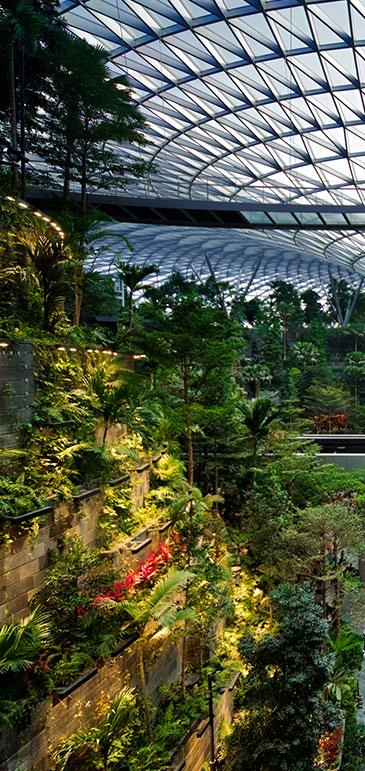
5 minute read
Yet Another Call for Sustainable Construction by Ernest Nyakundi
The date is September 20th 2019. It begins like all other Fridays do. Unlike other Fridays, however, on this one history is about to be made. In an almost seamless fashion, an approximate 4 million people line up the streets of the world. The reason for this – climate change. This becomes the largest climate protest in history to date. One detail that is not to be missed is the person at the centre of the protests. It is a girl; a teenage Swedish girl to be precise. Greta Thunberg is her name. A few weeks before this date, she received an invitation to speak at The UN Climate Action Summit in New York City; for her efforts as a climate activist. In order to make it to the summit, she has sailed across The Atlantic on a zeroemissions yacht accompanied by her father and supporting crew.
Earlier in the year, a trend Greta would be proud of unfolded in Europe’s political scene. The ‘Greens’ surged as their constituent parties made their strongest ever showing in Europe. The ‘Greens’ refers to a group of political parties with an ideology that aims to foster an ecologically sustainable society rooted in environmentalism, nonviolence, social justice and grassroots democracy. The main selling point for the Greens in 2019 was combating climate change and an increased number of Europe’s citizens rallied behind them. Conventional wisdom dictates that fighting change is absurd. In fact, it advises that we embrace the change and in some cases push for it. If we were to follow conventional wisdom to the letter, we would be fighting for climate change not against it. We would not be fighting to maintain similar climatic conditions. Conventional wisdom might have prevailed early on. As the climate got warmer on the heels of the industrial revolution, scientists in the 1890s were pleased and in fact welcomed climate change claiming it would usher in equable and better climatic conditions especially with regards to the colder regions of the earth.
Advertisement
It is only later on that they began to realize that changes in climatic conditions had adverse effects on the ecosystem. Even presently, in the face of all scientific findings, we still have climate change deniers in our midst. A notable one is former US President Donald Trump. The climate change deniers refute claims that the change is adverse. They counter claims that there is something humanity can do about it. They even go ahead to contradict findings that the global climate is indeed warming. Contrary to what climate change deniers claim, the global climate is indeed changing and the changes we are witnessing are adverse. Here is a simple breakdown. The earth is warming since more heat is getting trapped in our atmosphere. The heat is getting trapped in our atmosphere due to the effect of greenhouse gases. The largest contributor to greenhouse gas emissions is human activities. The built environment is a direct contributor of more than 30 percent of all the greenhouse gas emissions. That’s right. The built environment is a major contributor to the adverse climate changes we are witnessing.
FEATURES
A warming earth is causing polar ice to melt. This threatens to wipe out the entire polar ecosystem. As the polar ice melts, the sea levels are increasing. Unchecked, this is bound to effectively displace millions of people in the near future. Other effects of the warmer earth are unpredictable weather patterns which are affecting agriculture hence our food security, severe catastrophes such as stronger tsunamis, frequent floods, rampant wildfires such as those witnessed in Australia and the Amazon rainforest, prolonged droughts, among others. The list of adverse effects is endless.
So, how can we, professionals in the built environment, reduce our sector’s contributions to the global greenhouse gas emissions? The answers to this question have already been presented in numerous articles before this. In fact, most, if not all of us, know what we are supposed to do; having been taught sustainable construction practices as part of our academic programmes. Nonetheless, there being no harm in a gentle reminder, I will restate some of the solutions. There are three main stages in a building’s life cycle; design, construction and maintenance. Incorporating sustainable practices in all these stages is crucial if we are to achieve lower greenhouse gas emissions. However, for this article, I would like to focus on the design stage. I am under the impression that should sustainability be incorporated in design, it will be adopted in all the other subsequent stages. So, what can the design team do during the design stage to achieve sustainable buildings?
In the design stage, a climate-conscious architect will come up with a design that is inherently ‘green’. This type of design should lead to a building that consumes as little energy as possible and more preferably, one that utilizes green energy such as solar and wind. The climate-conscious quantity surveyor (QS) on the other hand will preferably do a lifecycle costing of the proposed development instead of the normal Bills of Quantities.

Why lifecycle costing? Because green buildings tend to be approximately 7% more expensive than their non-green peers yet most of the initial costs required to develop them are offset by lower operational costs. Therefore, a climateconscious QS will go beyond the Bills of Quantities and in his arsenal for the developer have a lifecycle costing of the proposed development.
Other measures that can be taken in the design stage to improve sustainability include energy auditing the designs, incorporating grey water recycling techniques in the designs, making the internal building climate comfortable without the use of air conditioning systems and maximizing penetration of natural light.
These are just some of the measures that can be adopted in the design stage of construction projects. By mindfully adopting any of them, you are in a small way, contributing to a greener planet. A greener planet is a better home for all of us and is without doubt the best inheritance we can confer upon future generations. Sustainable construction is the trend to adopt. Let’s all build green!
Let’s all Build Green!
AUTHOR BIO
Ernest Nyakundi is the Managing Director of Grey Arc Limited, a construction company based in Nairobi. He has a Bachelor’s Degree in Quantity Surveying from The University of Nairobi. He is a member of the AAK Quantity Surveyors Chapter.




